The Philippines is a top destination for surfers, with numerous beaches and desirable waves. Siargao's Cloud 9 is a popular spot, known for powerful barrels. This location attracts experienced surfers looking for a challenge.
La Union offers consistent breaks suitable for all skill levels, making it an ideal location for beginners and experienced surfers alike.
Another notable spot is Baler, which is considered the birthplace of Philippine surfing. Baler's beaches welcome surfers of all experience levels, from newbies to professionals.
The best time to surf in the Philippines is from August to November, when typhoon swells create epic conditions.
To cater to surfers' needs, various surf camps and accommodations are available. Engaging with the local surf community allows for a unique cultural experience and can provide insight into other surfing spots within the islands.
Overview of Surfing in the Philippines
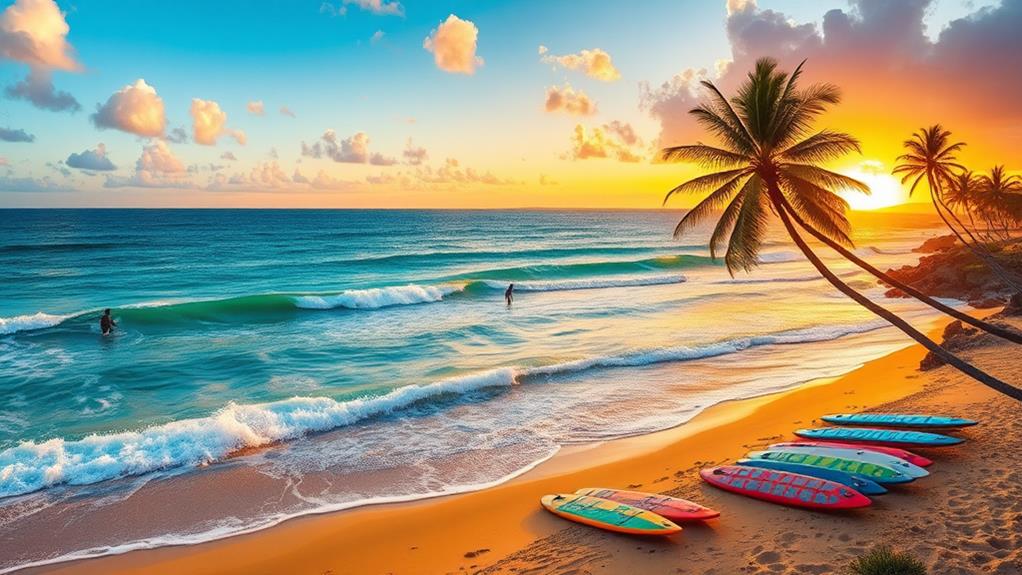
The Philippines offers a diverse range of surf spots for all skill levels. With over 7,000 islands and a coastline of 36,000 km, the country provides numerous surfing opportunities. One notable example is Siargao, famous for its Cloud 9, a world-class surf break that has attracted both local and international surfers since the late 1980s.
Cloud 9 in Siargao is a must-visit surf break, known for its powerful waves and breathtaking scenery. This break is ideal for experienced surfers, offering a thrilling experience that combines speed and maneuverability. The waters surrounding Cloud 9 are generally calm, with occasional strong currents that require attention from surfers.
La Union is another popular surf destination, celebrated for its consistent beach and point breaks. The area offers reliable surf conditions that cater to a wide range of skill levels, from beginners to experienced surfers. This makes La Union an excellent choice for those looking to improve their surfing skills or enjoy a leisurely surf session.
The optimal surfing season in the Philippines is from August to November. This period coincides with the peak of typhoon swells, which create the best waves for riding. During this time, surfers can expect consistent waves and favorable surfing conditions.
The Philippines has a growing surf culture, with increasing participation in international competitions. This growth has led to a more vibrant and diverse surfing community, with a mix of local and international surfers. As a result, the thrill of surfing in the Philippines only gets better, with new surf spots and events emerging every year.
Geographic Location and Key Spots
The Philippines is a premier surfing destination in Southeast Asia due to its unique geographic layout, featuring an eastern coastline that consistently attracts Pacific Ocean swells. This archipelago comprises over 7,600 islands, making it an ideal location for surfers.
Siargao Island is a must-visit destination for surfers. It's home to the iconic Cloud 9, where the waves can challenge even the most seasoned surfers. This island offers a world-class surfing experience, making it a popular destination for surf enthusiasts.
Baler is the birthplace of Philippine surfing and offers a variety of surf spots suitable for all skill levels. This allows beginners to find gentle waves, while experienced surfers can enjoy more challenging breaks.
Another notable destination is La Union, the Surfing Capital of the North. Located near Manila, La Union provides consistent beach and point breaks that cater to both beginners and advanced surfers.
Other notable surf spots in the Philippines include Zambales and Dahican. Zambales boasts pleasant conditions, while Dahican is famous for its laid-back atmosphere and all-level beach breaks.
The best time to surf in these areas is typically during the wet season, when the swells are most reliable.
Best Surf Breaks to Explore
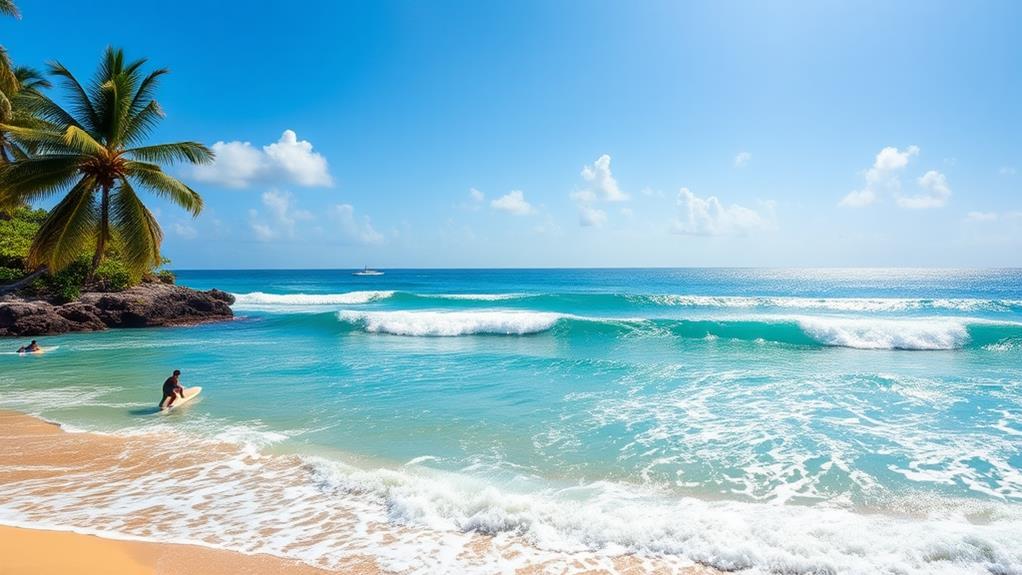
The Philippines is home to numerous exciting surf breaks that cater to various skill levels.
The Surfing Capital of the Philippines, Siargao, is a top destination for surfers. This island boasts some of the best surf spots, including Cloud 9. Cloud 9 is renowned for its powerful right-hand barrel waves, making it ideal for advanced surfers. These waves allow experienced surfers to ride short, barreling peaks over shallow coral.
Experienced surfers seeking more challenges can explore other surf breaks in the Philippines. Jacking Horse is a notable spot, offering hollow coral reef breaks with waves reaching up to 10 feet.
Rock Island features a fast right-hand point break that starts at 3 feet and can reach an exhilarating 12 feet.
Beginner surfers can find suitable spots in the Philippines as well. Bagasbas Beach in Daet is perfect for beginners, featuring gentle beach breaks with both left and right waves.
Stimpys offers a fun left-hand point break with hollow waves ranging from 6 to 10 feet, ideal for honing skills in a less crowded atmosphere.
Surfing Seasons and Conditions
The optimal surf season in the Philippines runs from August to November. During this time, typhoon swells create the perfect conditions for catching exhilarating waves.
In Siargao, often called the surfing capital, surf conditions peak from September to November, with powerful waves and consistent swells that attract surfers worldwide.
La Union and Zambales experience the largest waves from December to March. These areas benefit from northwest wind swells that can challenge seasoned surfers.
However, surf seasons can vary across regions, and unexpected peaks may occur in late winter and spring, especially in Siargao.
Local knowledge is essential to make the most of your trip. Weather patterns significantly influence wave quality and surf conditions. Staying informed helps you ride the best waves during your visit.
Regional weather patterns and specific surfing locations are crucial to understanding the best times for surfing in the Philippines.
Surf Camps and Accommodation

Surf camps in the Philippines offer a unique way to immerse yourself in the local surf culture. These camps, particularly in Siargao, provide all-inclusive packages that combine surf lessons, accommodation, meals, and additional activities.
Surf camps offer personalized attention and instruction. For example, Awake Siargao has a 2:1 teacher-student ratio, making it perfect for surfers of all skill levels. Another option is Mao Mao Surf, which features ISA-qualified instructors.
Accommodation options are diverse, ranging from budget-friendly hostels to stylish beach resorts. Single Fin Siargao is a stylish beach resort that offers a unique experience.
You can also book through platforms like BookSurfCamps.com, which offer various packages to match your surfing goals.
Booking a surf camp can be easy. Platforms like BookSurfCamps.com make it simple by offering a variety of packages.
Planning Your Surfing Trip
The best time to surf in the Philippines is between August and November. These months offer optimal surf conditions due to peak typhoon swells and offshore winds.
When planning a surfing trip to the Philippines, exploring surf destinations like Siargao, Baler, and La Union is essential. Each location offers unique waves and local scenes, catering to different surfing experiences. For instance, Siargao is known for its world-class waves, while Baler and La Union offer more laid-back surfing environments.
Booking a surf camp is a convenient option for surfers of all skill levels. Platforms like BookSurfCamps.com provide lessons, accommodation, meals, and activities designed specifically for surfers. This option helps ensure a smooth and enjoyable trip.
Travel insurance is crucial for protecting yourself during your surfing adventure. Consider securing insurance like SafetyWing to cover any unexpected events.
Renting a car can enhance your surfing experience by allowing you to explore multiple surf spots at your own pace. This option provides flexibility and independence during your trip.
To make your trip more budget-friendly, use flight comparison tools like Omio or Skyscanner to find the best deals on flights to the Philippines.
Once you arrive, travel apps like Traveloka can help you book accommodations and transport seamlessly.
Local Culture and Surf Community
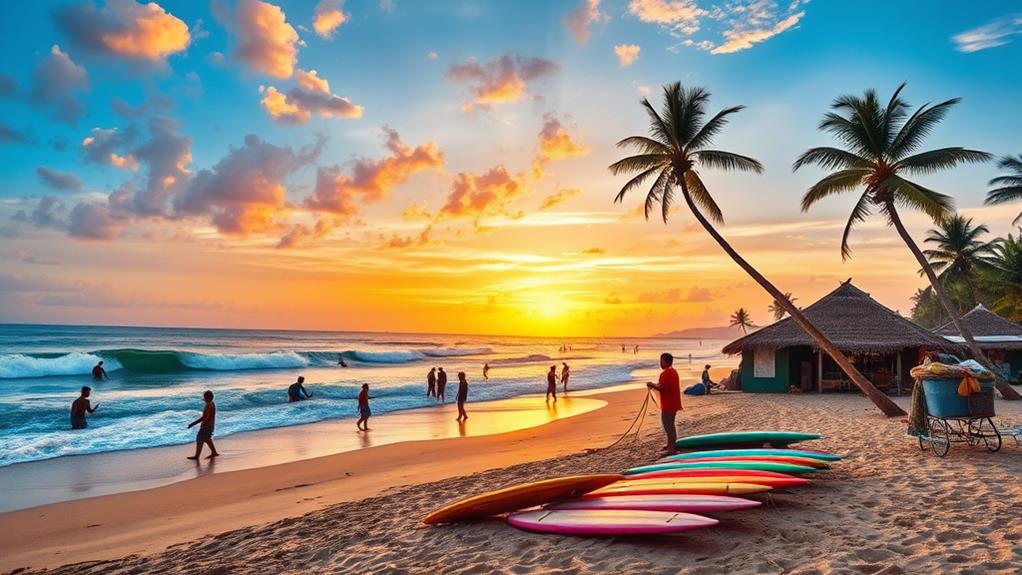
Surfing in the Philippines is deeply rooted in local culture and a vibrant surf community. The local surf communities emphasize respect for the ocean and fellow surfers, actively promoting sustainable practices through clean-up drives and environmental awareness campaigns.
Key aspects of the surf culture include:
- Annual surfing competitions, such as the Siargao Surfing Cup and the Baler Surf Competition, which draw both local talent and international participants. These events foster community engagement and boost tourism.
- Surf schools and camps, like Kermit Surf Camp and Surigao Surf School, that offer lessons and encourage cultural exchange. These institutions help connect visiting surfers with the local community by providing lessons from local instructors.
- Support for local businesses, such as surf shops like Kermit Surf Resort's surf shop and cafes like Shaka Cafe. These businesses create job opportunities and support the economy in coastal areas.
Essential Travel Information
The Philippines operates on UTC+08:00 time zone. This allows for easy trip planning, regardless of your starting location.
Understanding the time zone helps you prepare for your surf adventure and stay on schedule.
August to November is the best time to surf in the Philippines. During this period, typhoon swells create optimal wave conditions.
These conditions attract surfers worldwide and host surfing competitions.
The local currency is the Philippine Peso (PHP). It's recommended to carry some cash, as not all locations accept credit cards.
This helps you prepare for transactions and avoid any inconvenience.
Local ferries and budget-friendly inter-island flights are available for transportation. These options provide easy access to picturesque surf destinations.
Electricity in the Philippines runs on 220V. To accommodate this, pack an adapter compatible with plugs A, B, and C.
This ensures your devices stay charged throughout your trip.
Nearby Surf Destinations
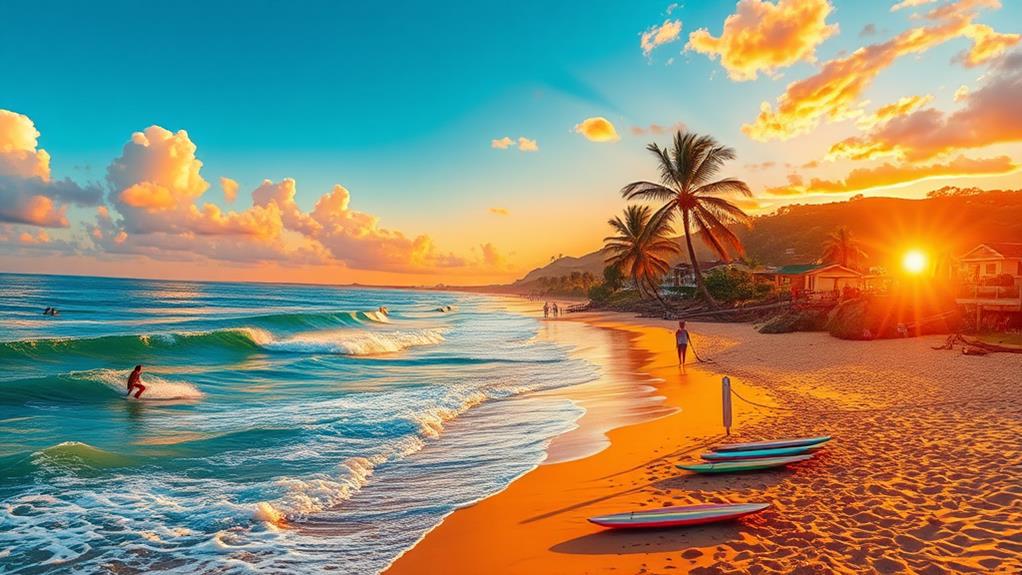
Nearby Surf Destinations
For those looking to expand their surf adventures, several nearby destinations offer great waves and pristine beaches.
1. Sri Lanka: This destination offers warm Indian Ocean waves with diverse conditions for surfers.
Sri Lanka's coastline, which spans 1,600 km, features mellow beach breaks and powerful reef breaks.
2. Bali: Bali is known for its vibrant surf culture, with a multitude of surf spots.
The island has something for everyone, ranging from beginner-friendly spots in the Bukit Peninsula to more challenging waves in Canggu.
3. Mentawai Islands: The Mentawai Islands are renowned for having some of the best waves globally.
This destination is perfect for experienced surfers, with consistent swells from November to March.
Popular Surf Competitions
The Philippines is a popular destination for surf competitions. The country hosts various events that attract both local and international surfers. One of the most popular surf competitions is the Siargao Cloud 9 Surfing Cup, an annual event that draws surfers from around the world.
The Philippine Surfing Championship Tour (PSCT) is another significant event that offers a series of competitions across the country.
The PSCT provides local surfers with opportunities to compete, gain recognition, and hone their skills. For example, the La Union Surfing Break in La Union, known as the Surfing Capital of the North, celebrates the region's rich surf culture through contests, live music, and community festivities.
The Philippines has also made its mark in international surfing competitions.
Philippine surfers have successfully participated in the International Surfing Association (ISA) World Surfing Games, solidifying the nation's presence in the global surfing community.
Safety Tips for Surfers
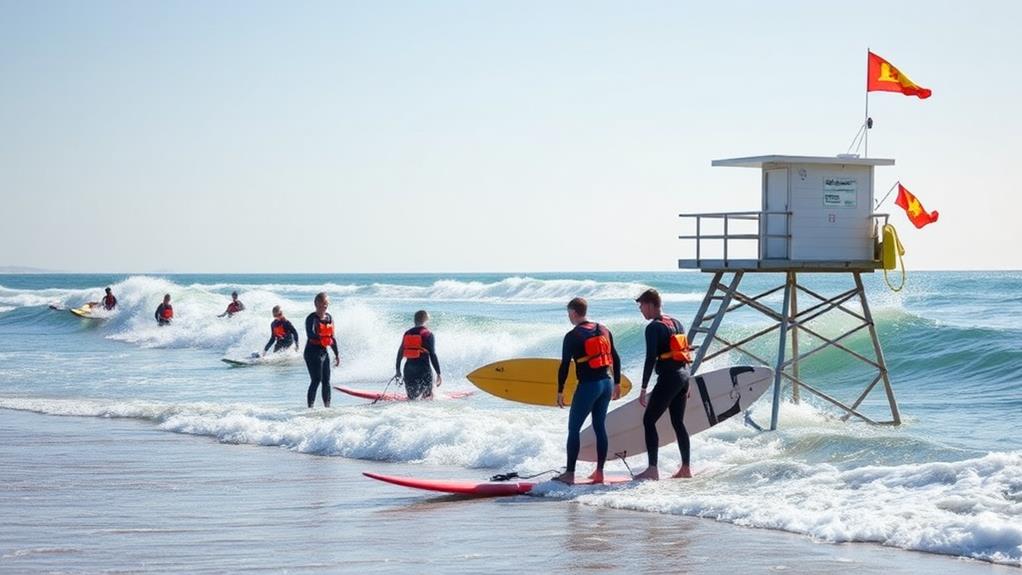
Surfing in the Philippines requires attention to safety to ensure an enjoyable experience. Key considerations include:
- Attach a surf leash to your board to prevent loss and reduce hazards. This simple step protects both you and other surfers from potential collisions.
- Understand local surf conditions before entering the water. Research the area to learn about potential dangers such as shallow reefs or strong currents. For example, the Philippines has many coral reefs that can be hazardous to surfers. Knowing the location of these reefs can help you avoid accidents.
- Protect yourself from the tropical sun by applying waterproof sunscreen regularly and staying hydrated. Dehydration and sunburn can be serious health issues, especially on cloudy days when the sun's UV rays are still strong. Bringing a water bottle and applying sunscreen every hour can help prevent these issues.
Additionally, invest in proper surfing gear, such as a wetsuit or rash guard, to protect against the elements and injuries. A wetsuit or rash guard can help prevent scrapes and cuts from sharp rocks or coral.
Practice good surf etiquette by respecting the right of way, avoiding drop-ins, and being mindful of your surroundings. This includes being aware of other surfers and swimmers in the water, and taking turns to catch waves.
How Do Social Issues in the Philippines Impact Surfing Tourism?
Surfing tourism in the Philippines faces challenges due to social issues crime drugs corruption philippines. These problems can tarnish the country’s reputation, making travelers hesitant to visit. Addressing these social concerns is crucial to ensure safety and stability, fostering a positive environment for surf enthusiasts and boosting local tourism-driven economies.
Eco-Friendly Surfing Practices
Embracing eco-friendly surfing practices is crucial for protecting the environment and enhancing your surfing experience. Supporting local surf schools and camps that prioritize sustainability contributes to conservation efforts. These schools often use biodegradable products and minimize waste, setting a positive example for all surfers.
Participating in beach clean-up initiatives is an effective way to give back to the community. Joining local surf communities in organized beach clean-ups at popular spots like Cloud 9 helps maintain pristine conditions.
Choosing accommodations that focus on responsible eco-tourism ensures your stay benefits both the local environment and community.
When interacting with marine wildlife, it's essential to be mindful of their well-being. Following guidelines to avoid disturbing whale sharks in Donsol supports responsible eco-tourism.
To minimize your impact, keep a safe distance, avoid touching, and never feed the whale sharks.
Advocating for and participating in local conservation programs is vital for protecting coral reefs and marine ecosystems. These ecosystems sustain biodiversity and maintain healthy surf conditions.
Questions and Answers
Where Is the Best Place in the Philippines to Try Surfing?
The Philippines offers several surf spots suitable for beginners, with Siargao Island being one of the most popular destinations.
When choosing a surf spot, look for locations with surf schools that can provide lessons on wave types, such as beach breaks and reef breaks. These schools often offer tips for beginners, including how to paddle, stand up, and balance on the board. Additionally, they can teach you about local surfing etiquette, such as respecting other surfers and the environment.
Many surf schools also offer surf gear rental services, which can help you get started without having to invest in your own equipment. Some popular surf spots in the Philippines even host surf competitions, which can be an exciting experience for both participants and spectators.
What Is the Best Time and Month to Surf in the Philippines?
The best time to surf in the Philippines is from August to November.
This period offers powerful waves, ideal for surfers. The season also boasts a vibrant local surf culture, making it perfect for both beginner lessons and surfboard rentals.
What Is the Surfing Capital of the Philippines?
Siargao is the surfing capital of the Philippines. This title is due to the island's abundance of vibrant surf culture, diverse wave types, and essential equipment for surfing. Local surf schools in Siargao offer lessons to those who want to learn surfing. Advanced surfing techniques are showcased in competitions held on the island.
Can You Surf in Coron, Philippines?
Yes, you can surf in Coron, Philippines. Coron surf conditions are best experienced during the typhoon season. There are diverse wave types in Coron, including reef breaks and beach breaks. Local surf spots include Malcapuya Island, Banana Island, and Coral Garden. To ensure water safety, check the weather forecast and ocean conditions before heading out to surf. Additionally, gear up with proper surfing equipment and consider seeking guidance from local surf instructors to explore Coron's unique surf culture.